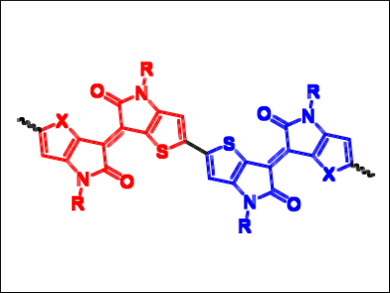To adjust the optoelectronic properties of polymers, acceptor–acceptor (A–A)-type moieties can be incorporated into donor–acceptor (D–A)-type conjugated polymers. However, the synthesis of functionalized A–A building blocks is often challenging.
Jianguo Mei, Purdue University, West Lafayette, IN, USA, and colleagues have developed an efficient convergent synthetic route to prepare bis-isoindigo-based A–A building blocks (pictured) via a palladium-catalyzed oxidative coupling. Four D–A–A type polymers were synthesized using the prepared building blocks and a ditin-functionalized donor moiety. All resulting polymers show high planarity and extended electron delocalization.
Compared with their D–A analogues, D–A–A polymers have a noticeably lowered LUMO (lowest unoccupied molecular orbital), but a relatively unchanged HOMO (highest occupied molecular orbital). The introduction of fluorine atoms into D–A–A polymers only lowers their HOMO levels. As a result, all D–A–A polymers exhibit ambipolar charge transport properties. By showing tunable selective frontier molecular orbital energy levels, these results suggest that the D–A–A design could play a significant role in developing ambipolar materials.
- Bis-isoindigos: New Electron-Deficient Building Blocks for Constructing Conjugated Polymers with Extended Electron Delocalization,
Xuyi Luo, Dung T. Tran, Hong Sun, Tianxiong Mi, Natalie M. Kadlubowski, Yan Zhao, Kejie Zhao, Jianguo Mei,
Asian J. Org. Chem. 2018.
https://doi.org/10.1002/ajoc.201800360




